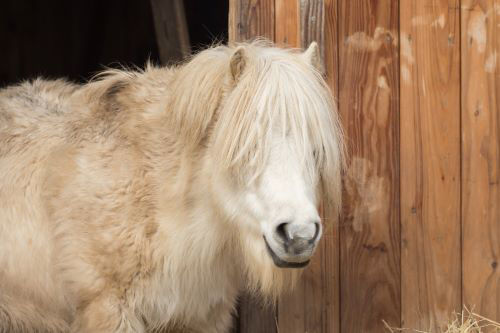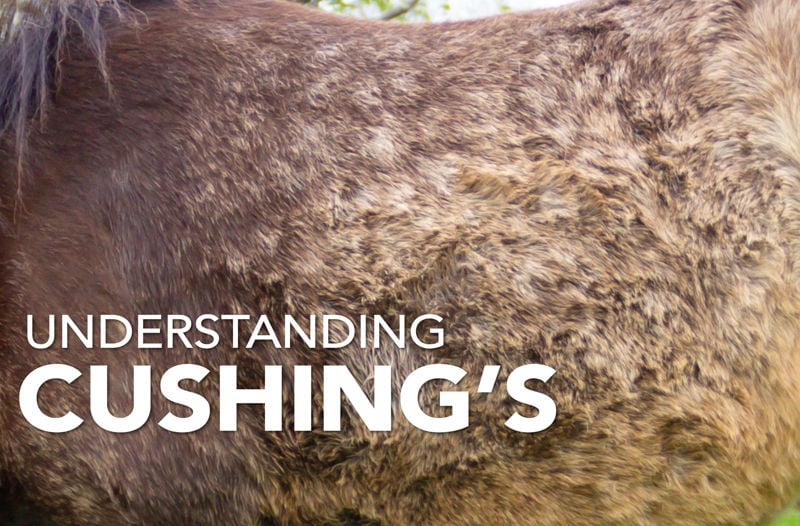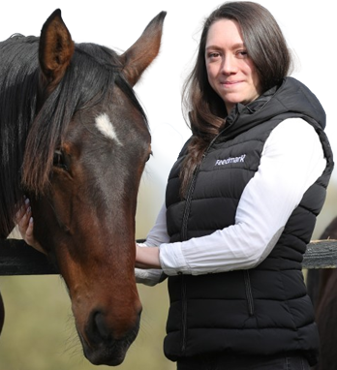Pituitary pars intermedia dysfunction (PPID) which is more commonly known as Cushing's, is a common disease predominantly diagnosed in horses and ponies, although it can also affect donkeys. In horses with PPID, the middle lobe of the pituitary gland (pars intermedia) becomes enlarged over time and results in an over production of hormones (AAEP, 2022), the most common being Adrenocorticotropic hormone (ACTH).
PPID is commonly referred to as Cushing’s, due to the similarities between the human condition of the same name, however, in humans Cushing’s disease affects a different location within the pituitary gland, which is why in horses the disease is scientifically referred to as PPID (AAEP, 2022). PPID is a condition associated with ageing, with studies showing that 15% - 30% of horses and ponies over the age of 15 are affected (Ireland and McGowan, 2018; EEG, 2021).
Symptoms of Cushing's in horses
Symptoms commonly exhibited by horses and ponies with PPID include;
- Increased risk of laminitis, usually due to Insulin Dysregulation
- Excessive hair growth - long and curly
- Poor coat quality
- Failure to shed a thick winter coat
- Excessive sweating (hyperhidrosis)
- Weight loss
- Muscle wastage
- Development of regional fat pads
- Excessive urination (polyuria)
- Excessive thirst (polydipsia)
- Recurrent infections
- Increased susceptibility to parasite infections
- Reduced response to pain
- Lethargy
- Change in appetite

Failure to shed a thick winter coat is a common symtom of Cushing's
Diagnosis and Treatment of PPID in horses
Horses and ponies displaying clinical symptoms of PPID, or those older than 10 years of age with chronic laminitis issues, should be assessed by a vet for the development of PPID. In addition, testing for Insulin Dysregulation is recommended in all PPID cases (Durham et al., 2014; EEG, 2021). If PPID is diagnosed the vet will lead the treatment and management plan which will incorporate drug therapy and management recommendations. Pergolide (brand name Prascend®) remains the medication of choice, with regular blood tests used to monitor Adrenocorticotropic hormone (ACTH) levels and response to treatment (EEG, 2021).
Management should be dictated by the symptoms the horse is displaying and can include;
- Providing correct hoof care to maintain hoof balance
- Increased monitoring of parasite burdens
- Regular dental care
- Monitoring of skin health due to increased susceptibility to skin infections
- Ensuring access to clean water is always available
- Providing appropriate pain relief
Feeding reccomendations for horses with Cushing's
Forage
Like all horses and ponies, fibre should be the main component of the diet for those with PPID. Forage should ideally be tested for its NSC (sugar and starch) content as there is no way of knowing the nutritional values without testing. It should not be assumed that meadow hay is low in NSC, as the level of NSC varies with climate, stage of growth, health of the plant when harvested and geographical area (Richards et al. 2021). Hay is recommended over haylage for horses and ponies with metabolic issues due to its lower digestible energy (DE) content, which is an important consideration for good-doers, although again DE levels should also be confirmed through laboratory analysis.
Soaking hay
Soaking continues to be used as a method to reduce NSC levels in hays, and current recommendations for horses and ponies with PPID, ID and EMS are to soak hay for a minimum of 60 minutes (EEG, 2020). A study by Argo et al. (2015) found that soaking grass hay at ambient temperatures for 7 hours decreased NSC levels from 18% to 14%, whereas soaking the hay for 16 hours in the same conditions decreased the NSC content from 18% to 10.5%.
In warmer conditions the time to achieve NSC losses is reduced and therefore soaking time can be shortened (Longland et al., 2014). This was demonstrated by Bochnia et al. (2021) who found that soaking hay at 22oC for just 15 minutes reduced NSC content by up to 24% and soaking for 30 minutes reduced NSC content by up to 34%. Due to concerns about hygienic quality of long soaking times, soaking duration should be restricted to 1-2 hours in warm weather (Moore-Colyer et al., 2014; Durham et al., 2019).
Hard feed
If additional energy is needed to maintain body weight feed options include higher energy fibre feeds such as alfalfa and oil-coated forages, high fat feeds such as linseed or oils, or appropriate concentrate feeds. All feeds should be low in NSC to help maintain low blood glucose and insulin levels. Ideally feedstuffs should have an NSC level less than 10% of dry matter (DM) (Borgia et al. 2011; Harris et al. 2017; EEG, 2020). This means that many concentrate feeds are not suitable for horses and ponies with PPID, however there are now feeds and supplements on the market specifically designed to provide energy/calories whilst having a low starch and sugar content.
How much to feed
The amount to feed will depend on the animal’s body condition. Those of lean condition should be fed forage at a daily intake of 2% - 2.5% of their body weight, whereas horses or ponies that are overweight should be fed a diet that supports weight loss. Daily food intake may need to be limited to 1.5% body weight as DM per day to induce weight loss, although this should be guided by your vet or a qualified nutritionist (Shepherd et al. 2021). If your horse or pony is being fed a restricted forage intake every effort should be made to extend eating time to support digestive health and allowing natural feeding behaviour. Ways this can be done include feeding from a small holed haynet, placing haynets in different places in the stable, using slow feeders and splitting the forage ration and feeding it at intervals throughout the day.
For some horses and ponies replacing a portion of the hay ration with clean, hygienic straw maybe enough to encourage weight loss whilst allowing them to eat for extended periods of time and perform normal feeding behaviours (Dosi et al. 2020). If straw is added to the diet, it should be introduced gradually to allow adaptation to the higher intake of indigestible fibre, and the straw should make up no more than 25% of the overall forage ration.
Pasture access and intake for horses with Cushing's
Non-structural carbohydrate levels of pasture vary considerably therefore management of intake is usually required for horses and ponies with PPID who can consume large amounts if given free access. Methods of pasture restriction include;
- Limiting grazing area – which can be achieved using electric fencing and works well combined with strip grazing.
- Limiting grazing time - only effective if the amount of pasture available is also limited as horses, and especially ponies, are able to increase their grass intake rate to compensate for the shorter grazing period (Ince et al. 2011; Wood et al. 2012; Glunk et al. 2013). Limiting grazing time is most effective when the available pasture is sparse, preventing this compensatory behaviour.
- Use of a grazing muzzle - can considerably reduce pasture intake whilst allowing animals to move freely, exercise and socialise. Grazing muzzles should be introduced gradually to give time for the horse or pony to become accustomed to wearing the muzzle and learning how to drink. If muzzles are worn for only part of the day, once the muzzle is removed compensatory intake of pasture may be seen (Longland et al. 2016; Davis et al. 2020).
During laminitic episodes the horse or pony should be removed from the pasture completely until the condition is under control and hoof structures are stable. Controlled pasture access may then be possible although some horses and ponies with PPID are very sensitive to pasture and are more stable on dry-lot turnout areas combined with controlled feeding of forages.
TOP TIP - Monitoring the amount of pasture available in a field can be challenging as fresh grass is often grazed as soon as it grows. As such, visual assessment of how much pasture there is available to eat is difficult. Sectioning off a small area of the field (1-2m2) with electric fencing prevents new growth being consumed and allows pasture availability to be monitored. The fenced area should be in parts of the field which are actively grazed and it should be moved every 1-2 weeks to ensure an accurate representation of the pasture being consumed.
Summary
Pituitary pars intermedia dysfunction, othewise known as Cushing's, is a disease affecting primarily older horses and ponies, but should be considered over the age of 10 with recurrent laminitis. Abnormal hair growth and shedding, changes in body condition and composition, polyuria, polydipsia, and reduced immunity are the most common symptoms. A diet low in starch and sugar, high in fibre and balanced for protein, vitamins and minerals is advocated alongside controlled pasture intake. Quality of life for equids with PPID is increased where feeding and management recommendations are combined with appropriate veterinary treatment.
For any advice or questions you may have, please don't hesitate to reach out to our expert nutrition team. You can call 0800 585525 Monday-Friday 8:30am-5:00pm. Email [email protected], or send us a DM on social media.
References
- AAEP (2022) ‘Equine Cushings Disease: Equine Pituitary Pars Intermedia Dysfunction’ Available at https://aaep.org/issue/equine-cushings-disease-equine-pituitary-pars-intermedia-dysfunction
- Argo, C., Dugdale, A.H.A. and McGowan, C.M. (2015) ‘Considerations for the use of restricted, soaked grass hay diets to promote weight loss in the management of equine metabolic syndrome and obesity’, The Veterinary Journal, 206, pages 170-177.
- Bochnia, M., Pietsch, C., Wensch-Dorendorf, M., Greef, M. and Zeyner, A. (2021) ‘Effect of Hay Soaking Duration on Metabolizable Energy, Total and Prececal Digestible Crude Protein and Amino Acids, Non-Starch Carbohydrates, Macronutrients and Trace Elements’, Journal of Equine Veterinary Science, 101: 103452.
- Borgia, L., Valberg, S., McCue, M., Watts, K. and Pagan, J. (2011) ‘Glycaemic and insulinaemic responses to feeding hay with different non-structural carbohydrate content in control and polysaccharide storage myopathy-affected horses’, Journal of Animal Physiology and Animal Nutrition, 95(6), pages 798-807.
- Davis, K.M., Iwaniuk, M.E., Dennis, R.L., Harris, P.A. and Burk, A.O. (2020). ‘Effects of grazing muzzles on behavior and physiological stress of individually housed grazing miniature horses’, Applied Animal Behaviour Science, 231: 105067.
- Dosi, M., Kirton, R., Hallsworth, S., Keen, .J and Morgan, R. (2020)., 'Inducing weight loss in native ponies: is straw a viable alternative to hay? Inducing weight loss in native ponies: is straw a viable alternative to hay?', Veterinary Record. https://doi.org/10.1136/vr.105793
- Durham, A,E., Frank, N., McGowan, C.M., Menzies-Gow, N.J., Roelfsema, E., Vervuert, I., Feige, K. and Fey, K. (2019) ‘ECEIM Consensus Statement on Equine Metabolic Syndrome’, Journal of Veterinary Internal Medicine, 33, pages 335-349
- Durham, A.E., McGowan, C.M., Fey, K., Tamzali, Y. and van der Kolk, J.H. (2014). ‘Pituitary pars intermedia dysfunction: diagnosis and treatment’, Equine Veterinary Education, 26(4): pages 216-223.
- Equine Endocrinology Group (2020). ‘Recommendations for the Diagnosis and Treatment of Equine Metabolic Syndrome (EMS)’.
- Equine Endocrinology Group (2021). ‘Recommendations for the Diagnosis and Treatment of Pituitary Pars Intermedia Dysfunction (PPID)’. Available at: https://idppid.com/sites/idppid/files/pdf_download/2021%20EEG%20PPID%20Recommendations%20%281%29.pdf
- Glunk, E.C., Pratt-Phillips, S.E. and Siciliano, P.D. (2013). ‘Effect of Restricted Pasture Access on Pasture Dry Matter Intake Rate, Dietary Energy Intake, and Fecal pH in Horses’, Journal of Equine Veterinary Science, 39, pages 421-426.
- Harris, P.A., Ellis, A.D., Fradinho, M.J., Jansson, A., Julliand, V., Luthersson, N., Santos, A.S. and Vervuert, I. (2017). ‘Review: Feeding conserved forage to horses: Recent advances and recommendations’, Animal, 11(6), pages 958-967.
- Ince, J., Longland, A.C., Newbold, J.C. and Harris, P.A. (2011). ‘Changes in proportions of dry matter intakes by ponies with access to pasture and haylage for 3 and 20 hours per day respectively, for six weeks’, Journal of Equine Veterinary Science, 31, page 283.
- Ireland, J.L. and McGowan, C.M. (2018). ‘Epidemiology of pituitary pars intermedia dysfunction: A systematic literature review of clinical presentation, disease prevalence and risk factors’, The Veterinary Journal, 235, pages 22-33.
- Longland, A., Barfoot, C. and Harris, P. (2014). ‘Effect of water temperature and agitation on loss of water-soluble carbohydrates and protein from grass hay: implications for equine feeding management’, Veterinary Record, 174, page 68
- Longland, A.C., Barfoot, C. and Harris, P.A. (2016). ‘Efficacy of Wearing Grazing Muzzles for 10 Hours per Day on Controlling Bodyweight in Pastured Ponies’, Journal of Equine Veterinary Science, 45, page 22-27.
- Moore-Colyer, M.J., Lumbis, K., Longland, A. and Harris, P. (2014). ‘The effect of five different wetting treatments on the nutrient content and microbial concentration in hay for horses’, PLoS One, 9(11): e114079.
- Richards, N., Nielsen, B. and Finno, C.J. (2021). ‘Nutritional and Non-nutritional Aspects of Forage. Veterinary Clinics of North America: Equine Practice’, 37(1, pages 43-61.
- Shepherd, M., Harris, P. and Martinson, K.L. (2021). ‘Nutritional Considerations When Dealing with an Obese Adult Equine’, Veterinary Clinics of North America: Equine Practice, 37(1), pages 111-137.
- Wood, S.J., Smith, D.G., Morris, C.J. and Cuddeford, D. (2012). ‘The effect of pasture restriction on dry matter intake of foraging donkeys in the United Kingdom’, In: Saastamoinen M., Fradinho M.J., Santos A.S., Miraglia N. (eds) Forages and grazing in horse nutrition. Forages and grazing in horse nutrition, vol 132. Wageningen Academic Publishers, Wageningen.



